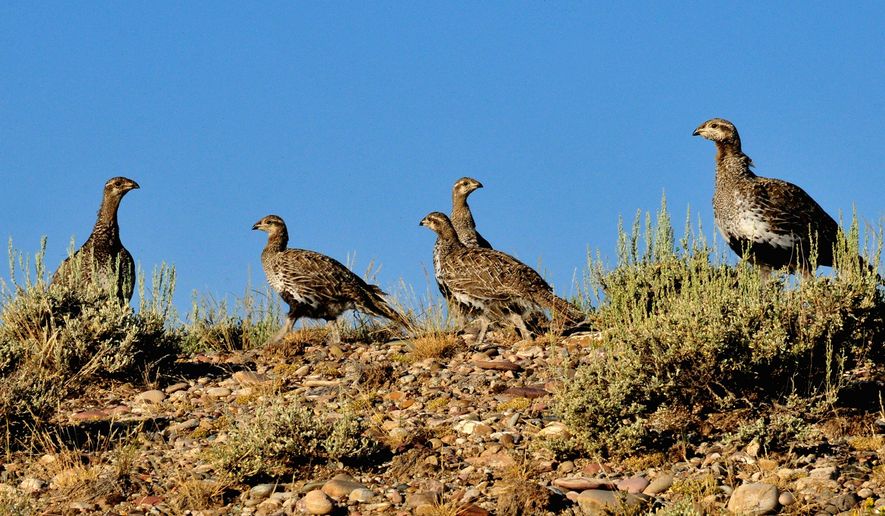DENVER | A coalition of rural Western counties and business interests is contesting the science being used to decide whether to list the Greater sage-grouse as endangered or threatened, accusing the Obama administration of relying on “selective, false and biased” research.
Denver attorney Kent Holsinger filed three Data Quality Act challenges Wednesday with the Department of the Interior on behalf of the coalition, which includes the Western Energy Alliance, ranchers, mining and drilling companies and 19 counties in Colorado, Montana, Nevada and Utah.
“We’ve documented real issues with transparency and scientific integrity,” said Mr. Holsinger in a statement.
He cited “extensive flaws in the agencies’ science,” saying the data demonstrate that federal agencies “exaggerate impacts from human activities while ignoring real threats like predation as well as natural fluctuations.”
“The steadfast reliance and perpetuation of flawed information reveals these agencies aren’t as much interested in sage-grouse conservation as they are in controlling our economy and Western way of life,” Mr. Holsinger said.
He added that obtaining the research wasn’t easy, calling it “unacceptable that we’ve had to resort to multiple lawsuits under the Freedom of Information Act and other maneuvers to obtain basic scientific information that should have already been provided to the public.”
The Fish and Wildlife Service has until Sept. 30 to decide whether to list the Greater sage-grouse as endangered or threatened under the Endangered Species Act, a move with potentially devastating economic consequences for the Western United States.
The Greater sage-grouse’s habitat is enormous, spanning 165 million acres in 11 Western states, 64 percent of which sits on federal land. Western governors and lawmakers have urged Interior officials to leave sage-grouse habitat recovery in state hands, pointing to the strides made by a multitude of local initiatives, while environmental groups have pushed for a federal listing.
Randi Spivak, director of the public lands program for the Center for Biological Diversity, said the coalition’s data challenge represents “the energy industry sort of reacting to conclusions that they just don’t like.”
She said the Bureau of Land Management study, known as the NTT Report, is “based on the best available science,” while the Fish and Wildlife Service Conservation Objectives Team Final Report “would mean restrictions for the oil and gas industry in sage-grouse habitat.”
“Any time there are any restrictions, whether it’s for wildlife or health or safety, you hear the oil and gas industry complain,” Ms. Spivak said.
The coalition’s data challenges focus on three “highly influential” scientific reports, prepared by the BLM, FWS and U.S. Geological Survey, that rely on data from “an insular group of “scientist-advocates” who skew their research to advance “policies they personally support,” according to the executive summary.
“The Reports were developed with unsound research methods resulting in a partial and biased presentation of information, and peer reviewers have found them to be inaccurate, unreliable, and biased,” the summary says. “They contain substantial technical errors, including misleading use of authority and failure to address studies that do not support a federal, one-size-fits-all narrative.”
For example, the coalition says the reports are quick to blame human activity for the bird’s decline but fail to give proper weight to the impact of predators such as ravens, even though their population has increased by 300 percent and local raven-management efforts in states like Nevada have shown success in boosting grouse habitat.
The three reports “all fail to recognize predation as the single most important factor affecting the abundance” of the Greater sage grouse,” according to one of the coalition challenges.
Interior officials emphasize that they are working with state governments, local communities, ranchers and others to restore sage-grouse habitat, including the restoration of 4.4 million acres of habitat through the Sage Grouse Initiative.
Meanwhile, state and local officials have been scrambling to demonstrate their commitment to saving sage-grouse habitat in order to avoid a listing.
Wyoming Gov. Matt Mead and Interior officials unveiled at a ceremony Wednesday in Cheyenne the nation’s first Greater sage-grouse conservation bank, which allows energy companies and others working on sage-grouse habitat to offset it by arranging for the protection of habitat elsewhere in the state.
“Wyoming continues to work on practical and effective means to ensure a healthy population of sage-grouse,” Mr. Mead said in a statement. “Here private landowners, state and federal agencies worked together, and the result is this innovative conservation plan.”
The Fish and Wildlife Service estimates the Greater sage-grouse population at between 200,000 and 500,000, which represents a 30 percent decline since 1985.
• Valerie Richardson can be reached at vrichardson@washingtontimes.com.




Please read our comment policy before commenting.